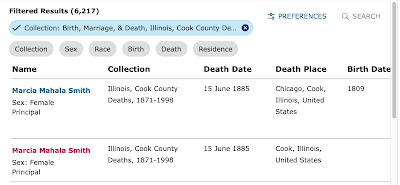 |
| Cook County Clerk, Genealogy Online (https://genealogy.cookcountyclerk.com). |
It used to be that researchers could log into the website to search for births, marriages, and deaths. If a good match was found, the corresponding record could be purchased online and downloaded immediately. If not, it was possible to dig around the site to locate a hard-to-find pdf order form that could be mailed in to request a manual search.
The new website simply provides a multi-screen form that visitors can fill out to request a vital records search.
I'm ambivalent about the loss of the old search feature because, frankly, I almost never used it. I found it much more productive to search indexes on FamilySearch and/or Ancestry for the records I needed. If I found a match, I'd check to see if the record was available from FamilySearch for free by visiting a Family History Center. If not, I'd check the Cook County site to see if I could get the record there. But, the collection wasn't complete, so filling out a form and mailing in a search request was sometimes the only option.
I'm not bothered by the need to put a search in the hands of a clerk. The few times I visited in person to ask for records, the vital records employees who helped me did their best to search their computers for digital copies of the records I needed. I'd like to think they work hard to fulfill requests even when someone isn't watching.
With the new system, there will be times, of course, when researchers receive records that aren't a good match for the ones they've requested. And how do I know that? Because I did vital records retrieval from FamilySearch microfilm for ten years and there were a few times when, for example, I located the correct record, copied the wrong record, and sent it out to a client without noticing. I was careful and, frankly, good at what I was doing, but there were days when I was overtired, working long hours to get records out quickly to satisfy clients, and sometimes I made mistakes. When I discovered them, I corrected them immediately. I'd like to think the Clerk's Office, when approached with patience and understanding, would do the same.
To me, the main downside to the website change is that later records--the ones that aren't available on FamilySearch for free--are no longer available immediately. I like instant gratification when I'm on a research roll, but I can live with that. If I needed something in a hurry--which is rarely the case--I'd just hire a Chicago researcher to visit a vital records office to retrieve it in person. I'm guessing that option is still available?
The upside is that we've gained is an easy way to request records from the Cook County Clerk's Office online. And, I really like the screen that warns researchers to request "legal certified copies" for a variety of purposes including dual citizenship and lineage society application documentation. It seems like they're trying to help people have a good experience.
I went through the process without ordering and learned that a death certificate request requires, at a minimum, a name and a death year. All other fields are optional and there's a space for added information. The form provides a field for file numbers which makes me think that the website creators think that researchers will check indexes elsewhere before visiting the new page.
What about that required death year? If the death year is unknown, I'm thinking a best guess with a note that gives a range would be acceptable. If a name can't be found in an index, it's generally possible to narrow down a death date using census records, city directories, and the like and, really, we should do our best to do that in a precise sort of way before ordering anyway.
The one thing I think could be improved is the stated turnaround time. The website suggests it might take 10-21 business days to receive a record. I have no idea how many requests are received each day but I know how long it takes for one efficient person to retrieve records from microfilm and I know how quickly digitized records can be retrieved from FamilySearch. I think turnaround times could--and should--be improved for straightforward retrieval requests. It would make researchers happy (great PR, right?) and it seems like it would relieve stress. If there really is a backlog, it's got to weigh on people.
There are some search tools that I miss -- like the old HeritageQuest options for searching census records -- but I don't think the search feature that was on the old Genealogy Online website is going to be one of them.







